You need to configure APPGW1 to support end-to-end encryption. The solution must meet the security requirements. What should you do?
You need to configure a security rule for APPGW1-NSG1. The solution must support the planned changes. Which service tag should you use?
You need to configure a custom rule for APPGWI-WAFPolicy to allow only connections that originate from FD1. The solution must support the planned changes.
Which Match type and Match variable should you select?
You need to configure FD1 to provide user access to app2.proseware.com. The solution must meet the security requirements and the general requirements.
What should you do first?
You need to identify which IP address space to allocate for the planned deployment of PRDNS1 to HubVNet and SpokeVNet. The solution must meet the general requirements
What should you identify for each virtual network? To answer, select the appropriate options in the answer area. NOTE: Each correct selection is worth one point.
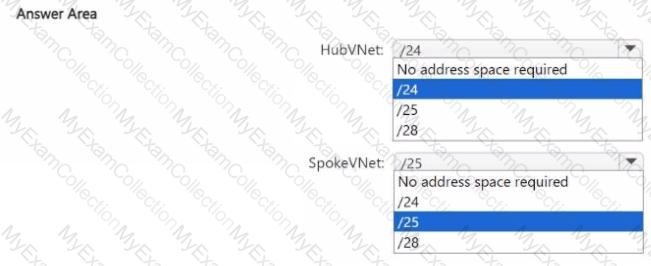
Which virtual machines can VM1 and VM4 ping successfully? To answer, select the appropriate options in the answer area.
NOTE: Each correct selection is worth one point.
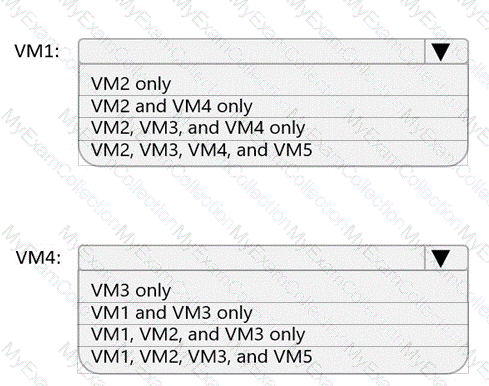
You need to configure GW1 to meet the network security requirements for the P2S VPN users.
Which Tunnel type should you select in the Point-to-site configuration settings of GW1?
In which NSGs can you use ASG1 and to which virtual machine network interfaces can you associate ASG1? To answer, select the appropriate options in the answer area.
NOTE: Each correct selection is worth one point.

You are implementing the virtual network requirements for VM Analyze.
What should you include in a custom route that is linked to Subnet2? To answer, select the appropriate options in the answer area.
NOTE: Each correct selection is worth one point.
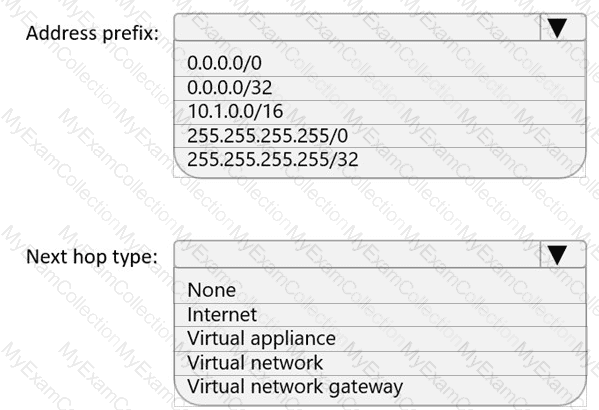
For each of the following statements, select Yes if the statement is true. Otherwise, select No.
NOTE: Each correct selection is worth one point.

For each of the following statements, select Yes if the statement is true. Otherwise, select No.
NOTE: Each correct selection is worth one point.

You are implementing the Virtual network requirements for Vnet6.
What is the minimum number of subnets and service endpoints you should create? To answer, select the appropriate options in the answer area.
NOTE: Each correct selection is worth one point.

What should you implement to meet the virtual network requirements for the virtual machines that connect to Vnet4 and Vnet5?
You create NSG10 and NSG11 to meet the network security requirements.
For each of the following statements, select Yes it the statement is true. Otherwise, select No.
NOTE: Each correct selection is worth one point.

Task 1
You plan to deploy a firewall to subnetl-2. The firewall will have an IP address of 10.1.2.4.
You need to ensure that traffic from subnetl-1 to the IP address range of 192.168.10.0/24 is routed through the firewall that will be deployed to subnetl-2. The solution must be achieved without using dynamic routing protocols.
You need to meet the network security requirements for the NSG flow logs.
Which type of resource do you need, and how many instances should you create? To answer, select the appropriate options in the answer area.
NOTE: Each correct selection is worth one point.

Task 1
You need to ensure that virtual machines on VNET1 and VNET2 are included automatically in a DNS zone named contoso.azure. The solution must ensure that the virtual machines on VNET1 and VNET2 can resolve the names of the virtual machines on either virtual network.
You have an Azure subscription that contains a virtual network named VNet1. VNet1 has a subnet mask of /24. You plan to implement an Azure application gateway that will have the following configurations:
• Public endpoints: 1
• Private endpoints: 1
• Minimum instances: 1
• Maximum instances: 10
You need to configure the address space for the subnet of the application gateway. The solution must minimize the number of IP addresses allocated to the application gateway subnet.
What is the minimum number of assignable IP addresses required?
You have an Azure subscription that contains virtual networks, network security groups (NSGs), and virtual machines. You need to perform the following actions:
• Identify unknown traffic between the resources.
• Check the network connectivity between the virtual machines.
What should you use to perform each action? To answer, select the appropriate options in the answer area.
NOTE: Each correct selection is worth one point.
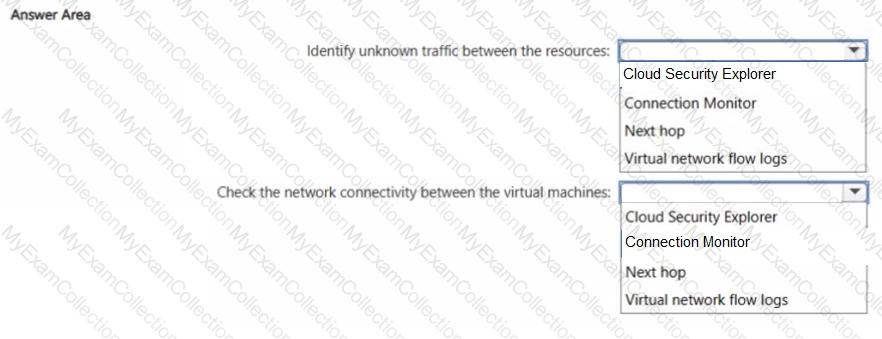
Task 3
You need to ensure that hosts on VNET1 and VNET2 can communicate. The solution must minimize latency between the virtual networks.
Task 2
You need to create an Azure Firewall instance named FW1 that meets the following requirements:
• Has an IP address from the address range of 10.1.255.0/24
• Uses a new Premium firewall policy named FW-pohcy1
• Routes traffic directly to the internet
You have an Azure subscription that contains a web app named App1 and an Azure Web Application Firewall (WAF) on Azure Front Door instance named FD1. FD1 manages traffic for App1.
You solution high levels of traffic to App1, the traffic is detected and blocked automatically. The solution must minimize administrative effort.
What should you include in the solution?
You have an Azure subscription that contains an Azure Front Door named FD1.
You plan to deploy an app named App1 by using Azure App Service. Users will access App1 by using FD1.
You need to provide FD1 with access to Appl. The solution must meet the following requirements:
• Ensure that users can only access App1 by using FD1.
• Ensure that users cannot access App1 directly from the internet.
What should you create for App1?
You have an on-premises VPN appliance named GW1.
You have an Azure subscription that contains an Azure VPN gateway named VPNGW1. VPNGW1 connects to GW1.
You need to modify the IKEv2 encryption algorithm used by VPNGW1 and GW1.
Which PowerShell cmdlet should you run? To answer, select the appropriate options in the answer area.
NOTE Each correct selection is worth one point.
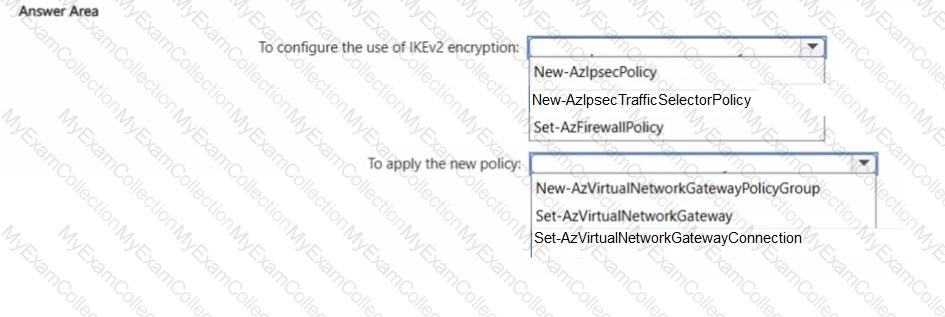
You have an Azure subscription that contains a virtual network named VNetl and the resources shown in the following table.

You need to implement a solution for the traffic onginating from VNetl. The solution must meet the following requirements:
• Perform transparent proxying to external web servers.
• Inspect all outbound TLS traffic.
• Minimize costs.
Which resource should you include in the solution?
You have an on-premises network.
You have an Azure subscription that contains a virtual network. You have an ExpressRoute service provider.
You plan to connect the Azure virtual network and the on-premises network by using an ExpressRoute circuit. You create a new ExpressRoute circuit. You need to provision the new circuit. Which information should you provide to the service provider?
Task 8
You need to ensure that the storage34280945 storage account will only accept connections from hosts on VNET1
Task 3
You plan to implement an Azure application gateway in the East US Azure region. The application gateway will have Web Application Firewall (WAF) enabled.
You need to create a policy that can be linked to the planned application gateway. The policy must block connections from IP addresses in the 131.107.150.0/24 range. You do NOT need to provision the application gateway to complete this task.
Task 4
You need to ensure that the owner of VNET3 receives an alert if an administrative operation is performed on the virtual network.
Task 7
You need to ensure that hosts on VNET2 can access hosts on both VNET1 and VNET3. The solution must prevent hosts on VNET1 and VNET3 from communicating through VNET2.
Task 8
You plan to deploy an appliance to subnet3-2- The appliance will perform packet inspection and will have an IP address of 10.3.2.100.
You need to ensure that all traffic to the internet from subnet3-1 is forwarded to the appliance for inspection.
Note: This question is part of a series of questions that present the same scenario. Each question in the series contains a unique solution that might meet stated goals. Some question sets might have more than one correct solution, while others might not have a correct solution.
After you answer a question in this section, you will NOT be able to return to it. As a result, these questions will not appear in the review screen.
You have an Azure subscription that contains the following resources:
* A virtual network named Vnet1
* A subnet named Subnet1 in Vnet1
* A virtual machine named VM1 that connects to Subnet1
* Three storage accounts named storage1, storage2. and storage3
You need to ensure that VM1 can access storage1. VM1 must be prevented from accessing any other storage accounts.
Solution: You create a network security group (NSG). You configure a service tag for MicrosoftStorage and link the tag to Subnet1.
Does this meet the goal?
You register a DNS domain with a third-party registrar.
You need to host the DNS zone on Azure.
Which three actions should you perform in sequence? To answer, move the appropriate actions from the list of actions to the answer area and arrange them in the correct order.

Task 10
You plan to deploy several virtual machines to subnet1-2.
You need to prevent all Azure hosts outside of subnetl-2 from connecting to TCP port 5585 on hosts on subnet1-2. The solution must minimize administrative effort.
You have two Azure virtual networks named Hub1 and Spoke1. Hub1 connects to an on-premises network by using a Site-to-Site VPN connection.
You are implementing peering between Hub1 and Spoke1.
You need to ensure that a virtual machine connected to Spoke1 can connect to the on-premises network through Hub1.
How should you complete the PowerShell script? To answer, drag the appropriate values to the correct targets. Each value may be used once, more than once, or not at all. You may need to drag the split bar between panes or scroll to view content.
NOTE: Each correct selection is worth one point.

You have an on-premises server named Server1 that runs Windows Server.
You have an Azure subscription that contains a virtual network named VNet1.
You plan to connect Server1 to VNet1 by using Azure Network Adapter.
You need to minimize how long it takes to deploy the adapter to Server1.
What should you create first?
Note: This question is part of a series of questions that present the same scenario. Each question in the series contains a unique solution that might meet the stated goals. Some question sets might have more than one correct solution, while others might not have a correct solution.
After you answer a question in this section, you will NOT be able to return to it as a result, these questions will not appear in the review screen.
You have an Azure subscription that contains an Azure Front Door Premium profile named AFD1 and an Azure Web Application Firewall (WAF) policy named WAF1. AFD1 is associated with WAF1.
You need to configure a rate limit for incoming requests to AFD1.
Solution: You modify the policy settings of WAF1.
Does this meet the goal?
Note: This question is part of a series of questions that present the same scenario. Each question in the series contains a unique solution that might meet the stated goals. Some question sets might have more than one correct solution, while others might not have a correct solution.
After you answer a question in this section, you will NOT be able to return to it. As a result, these questions will not appear in the review screen.
You have an Azure subscription that contains the following resources:
* A virtual network named Vnet1
* A subnet named Subnet1 in Vnet1
* A virtual machine named VM1 that connects to Subnet1
* Three storage accounts named storage1, storage2, and storage3
You need to ensure that VM1 can access storage1. VM1 must be prevented from accessing any other storage accounts.
Solution: You configure the firewall on storage1 to only accept connections from Vnet1.
Does this meet the goal?
You have an Azure subscription that contains an Azure VPN gateway named GW1. GW1 provides Point-to Site (P2S) VPN connectivity.
Users connect to GW1 from a Windows 11 device by using an SSTP connection.
You need to ensure that the P2S VPN connections support Microsoft Entra authentication.
Which three actions should you perform in sequence? To answer, move the appropriate actions from the list of actions to the answer area and arrange them in the correct order.
NOTE: More than one order of answer choices is correct. You will receive credit for and of the correct orders you select.

You need to implement name resolution for the cloud.liwareinc.com. The solution must meet the networking requirements.
What should you do? To answer, select the appropriate options in the answer area.
NOTE: Each correct selection is worth one point.

You need to connect Vnet2 and Vnet3. The solution must meet the virtual networking requirements and the business requirements.
Which two actions should you include in the solution? Each correct answer presents part of the solution.
NOTE: Each correct selection is worth one point.
You need to restrict traffic from VMScaleSet1 to VMScaleSet2. The solution must meet the virtual networking requirements.
What is the minimum number of custom NSG rules and NSG assignments required? To answer, select the appropriate options in the answer area.
NOTE: Each correct selection is worth one point.
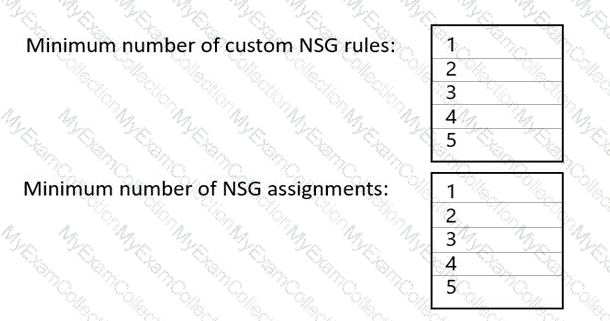
You have an Azure virtual network named Vnet1 that has one subnet. Vnet1 is in the West Europe Azure region.
You deploy an Azure App Service app named App1 to the West Europe region.
You need to provide App1 with access to the resources in Vnet1. The solution must minimize costs.
What should you do first?
Your company has offices in London, Tokyo, and New York.
The company has a web app named App1 that has the Azure Traffic Manager profile shown in the following table.

In Asia, you plan to deploy an additional endpoint that will host an updated version of App1. You need to route 10 percent of the traffic from the Tokyo office to the new endpoint during testi What should you configure in Traffic Manager?
You need to implement outbound connectivity for VMScaleSet1. The solution must meet the virtual networking requirements and the business requirements.
Which three actions should you perform in sequence? To answer, move the appropriate actions from the list of actions to the answer area and arrange them in the correct order.
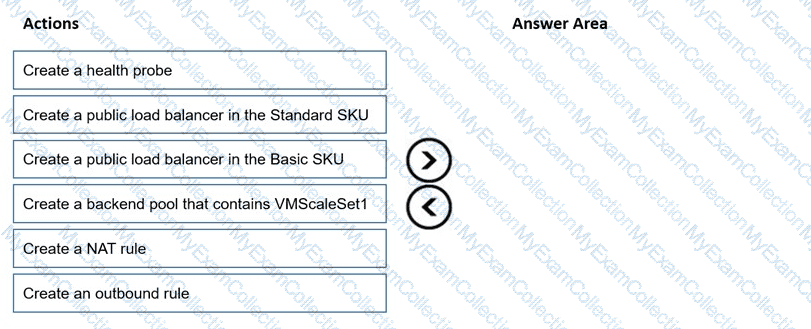
You need to implement outbound connectivity for VMScaleSet1. The solution must meet the virtual networking requirements and the business requirements.
Which three actions should you perform in sequence? To answer, move the appropriate actions from the list of actions to the answer area and arrange them in the correct order.

You need to provide access to storage2. The solution must meet the PaaS networking requirements and the business requirements.
Which connectivity method should you use?
You need to recommend a configuration for the ExpressRoute connection from the Boston datacenter. The solution must meet the hybrid networking requirements and business requirements.
What should you recommend? To answer, select the appropriate options in the answer area.
NOTE: Each correct selection is worth one point.

You need to configure the default route in Vnet2 and Vnet3. The solution must meet the virtual networking requirements.
What should you use to configure the default route?
You need to configure the default route in Vnet2 and Vnet3. The solution must meet the virtual networking requirements.
What should you use to configure the default route?
You need to provide connectivity to storage1. The solution must meet the PaaS networking requirements and the business requirements.
What should you include in the solution?
You need to implement a P2S VPN for the users in the branch office. The solution must meet the hybrid networking requirements.
What should you do? To answer, select the appropriate options in the answer area.
NOTE: Each correct selection is worth one point.

You need to manage connectivity from NYCNet to the Azure services that use private endpoints. The solution must meet the security requirements. What should you do first?























